Over the past few years, I have tried to streamline my routines. Feeling ready at the start of class has helped me to feel more confident and prepared for the rest of the hour. I hope you will find some of these ideas useful for your own classroom this year!
And make sure you visit the bottom of the post for access to free digital openers to try!
1) First check-in of the day? It happens at the door.
I have mentioned this in a few blog posts already, but it is worth repeating!
Each day I try to be outside my classroom door to greet students as they enter. It is a school-wide expectation at my school that teachers be visible in the hallways between classes, so that was an easy reason for me to start this tradition. We are expected to be in the hallways for the 5 minutes in between class blocks to supervise and be available to students. I teach in a school of almost 2,000, and hallways can get crowded! Teacher visibility helps to keep students moving toward their destinations.
At first, it felt like *just one more thing I had to do.* OK GREAT, I can’t use those few minutes to organize my desk, catch up on attendance, or write the warm-up. I was frustrated! It felt like wasted time. So I tried to find a positive way to use this time in the hallway. Instead of just standing there in front of my door staring off into space, I started to engage with the students as they walk by. I’ll talk to students I don’t know by asking a question or paying a compliment. If they’re wearing an athletic uniform, I’ll ask who they’re playing that day and wish them luck. It feels good to make connections!

As my own students trickle in, I make sure I greet them by name and ask how they are doing. It is actually a great way to check in with students without them knowing what you’re actually doing. If someone who is usually very talkative avoids my eye contact, I’ll know to take it easy on them that day. If my student who works at night looks really tired, I can assume she worked last night and I won’t give her a hard time about the homework. In general, if a student seems upset in any way, I can assume they may have a lot on their mind and I will remind myself during class that any reluctance or hesitation isn’t because of me. And conversely, if a quieter student smiles and gives me a confident answer, maybe I will try to push them a little bit outside of their comfort zone that day. That first connection can really help you be mindful of your class environment that day.
Sometimes, these small interactions make a much bigger impact than we might think. Last year, during my “Hola Aiden, ¿cómo estás?” moment… my quiet freshman boy opened up to me. “Miss, I think you’re the only teacher that likes me. You’re the only teacher that talks to me.”
Now there are mornings where I’ll be chatting with my neighboring teacher as we greet our students. Even as we talk, I will stop mid-sentence with her to greet each of my students by name. She may think I’m a weirdo for wanting to do this, as sometimes I am stopping to say “Hola, Casey” every 30 seconds… but I really do think it’s a valuable way to check in with my students before class has even started.
2) Teachers are multitasking ROCKSTARS
Checking homework, taking attendance and getting volunteers for the warm-up may seem like a lot. But if you can find a routine that works well for you, you can really do a lot in the first 5-7 minutes of class. Now, I have never actually discussed any of this with my students. I don’t do a lot of “explaining” routines, but I simply do them every day and my students catch on. They pay attention to what you do, and to how you start class each day. They want to know what to expect. Because it is routine for me, my students know the following pattern and by jumping on board, they actually help make my life a lot easier.
My students know that the warm-up will be written on the board when they enter. They also know that while they work on it, I will be coming around to check the homework (if there was any – I have actually stopped giving homework recently but more about that another time) or just to check in with them.
As I am walking around the room checking in with students while they are completing the warm-up, I am also marking any absent students in my planner. This way, when I finish my loop I can quickly walk to my computer and enter in the attendance without asking/calling any names. At this point, while I am standing at my computer, I ask for volunteers to answer the warm-up on the board. I often simply hold up a few markers with one hand as I’m typing into my computer and even looking at my computer. Without a word, students hop up to grab a marker (or I toss one to them if they make eye contact and nod — they love catching the markers.) Again, students are great at this because we do it every day and it becomes an unspoken routine. They know that they are expected to participate every day, and I always tell them that volunteering for the warm-up counts!!
After the volunteers are done writing on the board, I am usually done with MY tasks; homework credit has been checked, attendance has been entered, and the warm-up is done. We quickly discuss the warm-up as a class, and then we move on to reviewing the homework or starting our lesson. On a smooth day, all of these tasks are done by the 10 minute mark. (But pretty frequently I get a phone call that I forgot to enter attendance. Whoops….)
A quick note
As I mentioned I actually don’t assign homework anymore. But in case you do, I wanted to explain my fast grading system that helped streamline my start of class routine. I wrote this when I still assigned homework often:
My homework grades are as follows: I do not give homework every night, and I am actually trying to assign it less and less. But when we do have homework, each assignment is 2 points. If the assignment has been done on time and I can see it received a fair effort, the student earns 2 points. If it is done late (usually with us in class) the student earns 1 point. 0s are only given if the student never makes any attempt to make up the assignment, which is difficult since we always go over it in class.
To quickly mark these codes in my planner, I use the attendance/checklist/gradebook page. I make NO MARK if a student is present and has the homework that day. If a student does not have the homework, I draw a triangle in the top righthand corner of that day/assignment box. When they turn it in late, that triangle gets colored in. SO when I am adding them into my computer: no mark = 2 points. Empty triangle = 0 points. Filled-in triangle = 1 point. I hope this makes sense!
This is also the same page where I track attendance, so it was easy to multitask.
Looking for ways to stay organized?
You can see my printable Spanish Teacher Planner, including my attendance and homework trackers here.
Or check out my Spanish Teacher and Student Planner Bundle right here. With the student planner, students can keep all of their warm-ups in one place each week! There are different layouts for you to choose from, based on whether you see your students 4 or 5 days per week etc.
If you and your students work better digitally, my Editable Class Hub Sites are the way to streamline everything in one place!
3) Meaningful warm-ups
Need something to help you while you get in the habit of developing your own opener routines? Check out my EDITABLE bundle for Spanish 1 right here, or digital options here.
I have discovered that there are a few specific aspects of a warm-up that work best for me and my students. For one, I like them to be fairly quick. I feel best when the routines I mention above are done in 10-15 minutes max (including going over the homework!). Next, It is important for me to include visuals with the warm-ups whenever possible. This could be silly drawings by yours truly, or images projected on the TV (we are very very lucky to have iPads and apple TVs). Something I try NOT to include in my warm-ups is English! I try my best to make sure there is Spanish only. It is also important for me that there be something to share out after the warm-up. Lastly, I am mindful of whether the warm-up addresses reading, writing, speaking, listening…. or a mix of them!
An example of a visual warm-up during the intro to our family unit,
where students will also listen as I speak solely in the target language
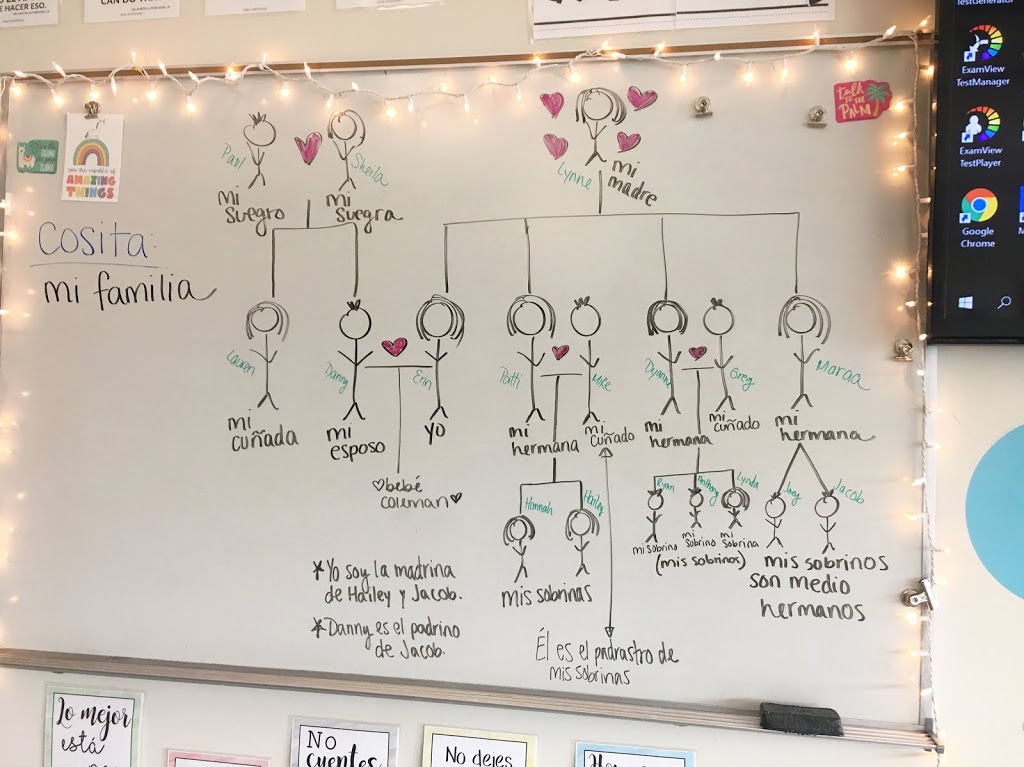
Examples
With that being said, these are my favorite types of warm-up activities. I have tried to order them from easiest to most difficult, however there are ways to differentiate each style and you may not completely agree with my order:
- List 3 — Worried about students avoiding the warm-up after a difficult lesson? My fall-back when my students are hesitant is a quick list. List 3 new words you remember from yesterday… list 3 of your favorite foods… list 3 words you need more help with… it can be anything! But it’s so easy that they can’t avoid trying 😉
- Correct my mistakes — I love to write 3-4 sentences on the board, and only write 1 completely correct. The other sentences have an error/errors of some sort, and I direct students to work with their groups to make corrections. There is often more than one correct way to do so, and I enjoy discussing the options with my students. “How ELSE could we have fixed this sentence?”
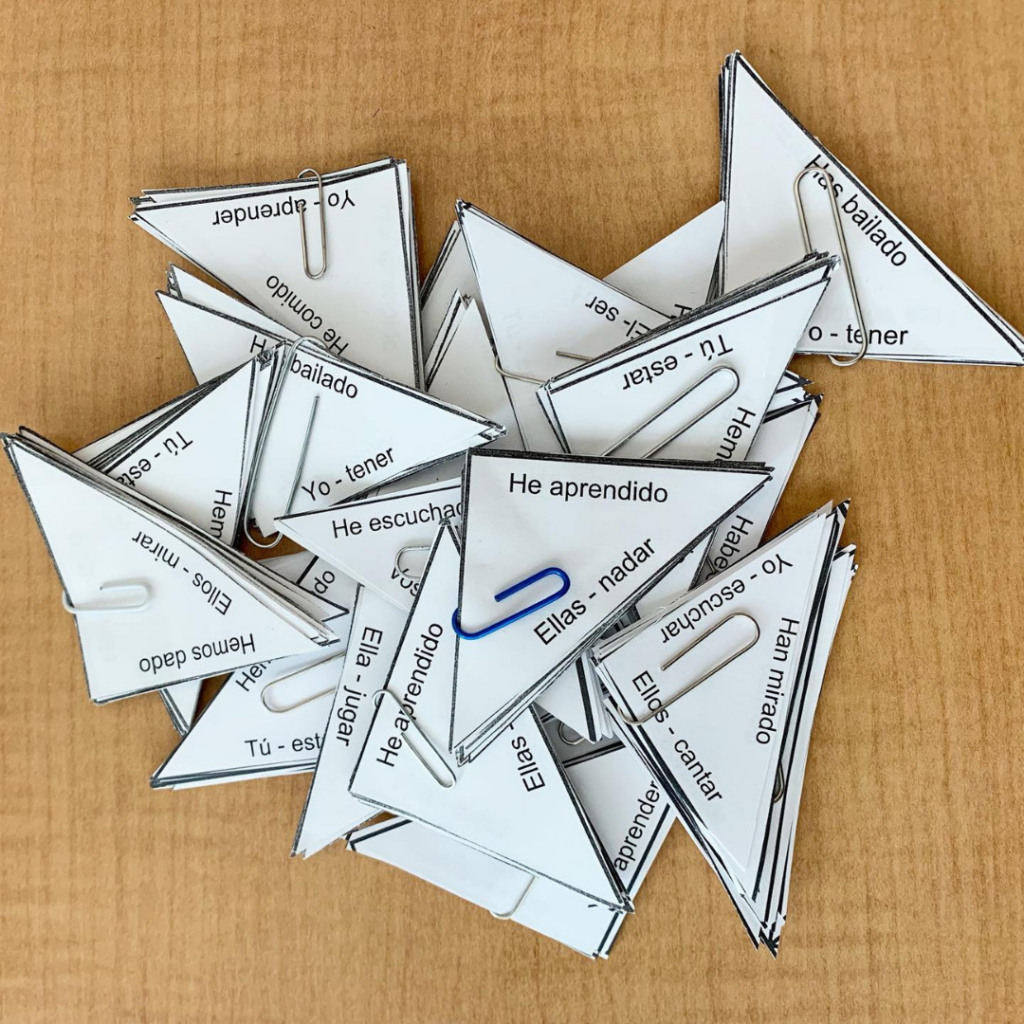
- Puzzles– Students can complete puzzles on the first or second day of a unit! I often use grammar puzzles before we have even seen the tense. With vocabulary, they can absolutely be used within the first few days as well. They are great for building confidence, and you can use them more than once! I sometimes have students race one another, or race against the clock. To see my favorite puzzles for class, click here. If you’d like editable templates to make your own, you can find multiple templates right here.
- True/False — 5 simple true/false statements written on the board. I like these because students don’t have to agree! What one student says is true, another may raise their hand to counter. For example “Me gusta el béisbol más que el fútbol.” You can then direct students to raise their hands to vote for the answer they chose.
- Logical/Illogical — ¿Es lógico o no? Along the same lines as true/false, but hopefully your students will come to the same conclusions rather than differing opinions. For example, “Me gusta patinar en la clase de español.” ….. No profe. No es lógico.
- Matching — ideal for new vocab or even a preview of vocab, since students can use process of elimination and make connections to cognates or known words to answer at least a few confidently! I often try to do silly little drawings here rather than use any English.
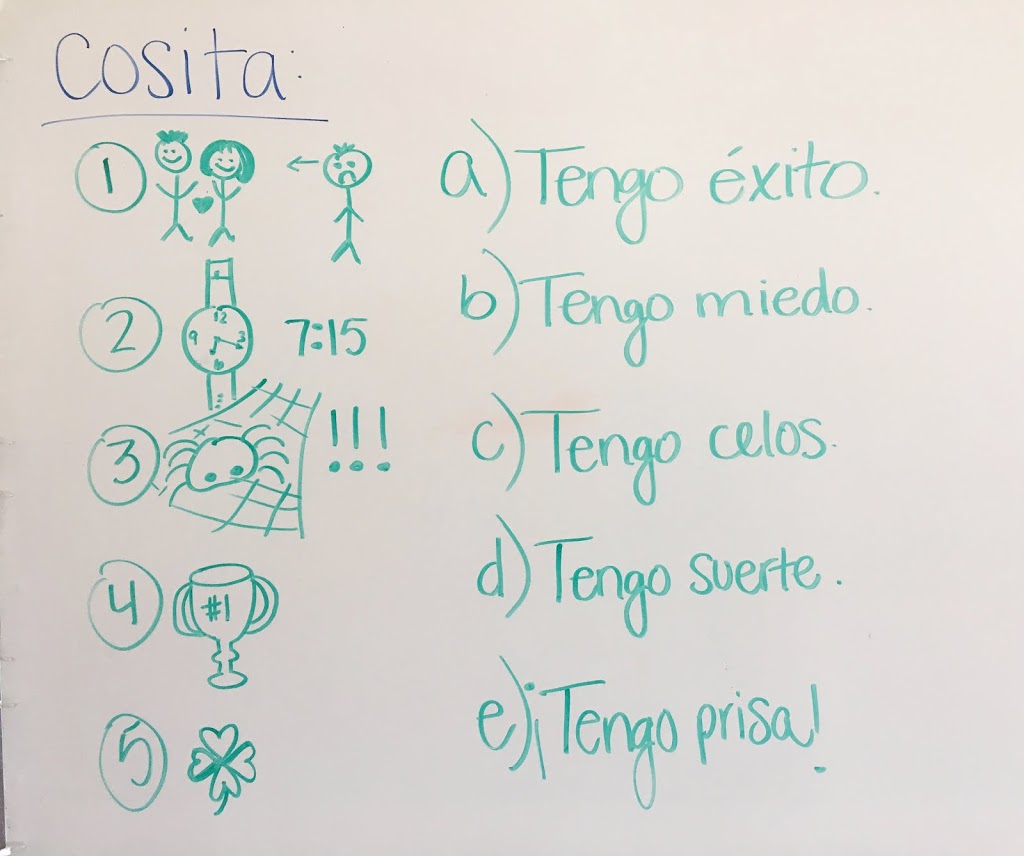
- Opposites— A great way to avoid using English, even with new vocabulary.
EXAMPLE
- Alto a) tímido
- Ambicioso b) bajo
- Extrovertido c) serio
- Cómico d) perezoso
Sometimes students come up with differing answers here, and it’s important to have a discussion about that! Are some of these words similar? So could more than one option fit?
You can also provide a word and ask students to provide an opposite. This leads to great discussions because students come up with varying answers 🙂
- Multiple Choice — Depending on the length of discussion you plan to have after each question, sometimes just 3 MC questions could be appropriate! These can be used for vocab, grammar, preferences, anything!
- Reading/Examining — When we start a new grammar unit, I try to get my students reading that tense / structure from the very first day. I will write 5-6 sentences on the board, and ask students to identify the present perfect verbs in my sentences along with their infinitives, for example. In these types of warm-ups, I motivate them to discuss with their groups throughout rather than working alone. This helps them to jump right into the unit before we have even really started!
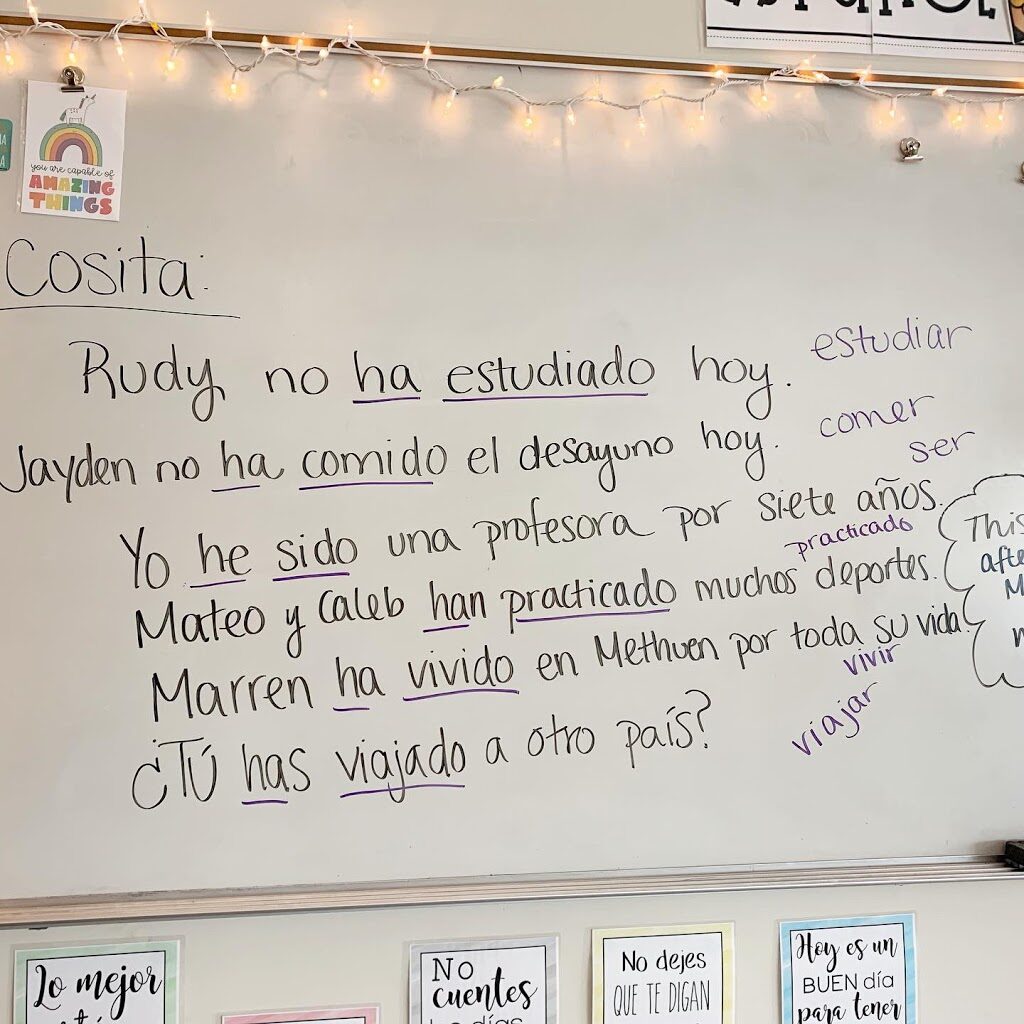
- Fill-ins — Looking to build confidence? Fill-ins offer something slightly more challenging than the other options I have mentioned so far, while still giving students the opportunity to use what IS in the sentence to help them. If you want to differentiate, consider adding a word bank (sometimes with extra words, or sometimes with multiple correct options!)
- Categories — Sometimes I will make a T chart on the board with two or more categories (such as me gusta / no me gusta…. or afuera / en casa) and I ask students to list 5 activities/terms in each category. Differentiate by requiring full sentences rather than single terms. Differentiate further by requiring students to add an extra category.
- Short response — When using these for a warm-up, I include 3 questions max. Often, I’ll write 3 but direct students to choose any 2 to answer. Providing student choice leads to more students completing the warm-up and fewer students saying, “I don’t know how to answer this.”
- Speak with your group — I am always trying to get my students to speak more, so I often try to include it in the warm-up OR during the last few minutes of class. That way, if a student has somehow kept fairly quiet during the class period, they still have an opportunity to produce the language aloud. My speaking prompts may say something along the lines of… “Habla con tu grupo y haz una lista de las 5 comidas mejores en la cafetería.” Or; “Habla con to grupo y explica, ¿cuál es tu deporte favorito? ¿Por qué?”
- Create a question — When I know my students are ready for a challenge, I ask THEM to create either: a statement with an error, a quick matching activity, or a short answer question. They then pass them in a circle around their group to challenge their partners. They love checking to see if the person gets it right! If you have more time, you can continue passing. 🙂
4) Preparing warm-ups for the full day
Before I explain this strategy, I want to acknowledge that it is not possible for everyone to do it exactly the way that I like to do it; however, as with any ideas I share, you can absolutely find a way to adapt it to your own practice.
I am aware that some teachers move between different classrooms, or don’t have the whiteboard space to do this. If you are in one of these situations, I highly suggest purchasing (or finding!) small whiteboards that you can carry with you OR easily prop up near the front of the room. If you aren’t interested in that, I would suggest doing this digitally. You could easily make it happen through Powerpoint or a Google Slides presentation (using a class hub for example). This routine has really lowered the stress level of my entire day, and given me more breathing room during the few moments in between classes.
My routine:
When I get to school each morning, I set up my warm-ups for the entire day. I usually have 3 classes to prep for, and I make space for each warm-up on the board. They are always written in the same place so students know where to look when they enter and sit down. Even if my warm-up requires my students to speak aloud with a partner or complete an activity digitally/on paper, I always create a space on the board for volunteers to share answers. No matter the format of our warm-up, there is always a way to share ideas on the board. Keeping this routine helps my students know what to expect each day, and gives them an opportunity to participate within the first few minutes of class.
Preparing my warm-ups for the entire day all at once and creating a designated space to do so allows me to check off one of one million tasks that are always on my teacher brain. Since I am expected to be in the hallway between classes (which I now enjoy!), preparing ahead of time means I no longer find myself scrambling to come up with an effective warm-up before rushing outside. Or worse… scrambling to write a warm-up as my students stare at the back of my head. I know that no matter what happens in between classes, my warm-ups have been well-thought out, and are set and ready for my students.
In regards to space:
I am lucky to have two large white boards at the front of my room, and one board is often used *solely* for warm-ups and announcements such as upcoming quiz days as well as information about the specific days that I’m available after school each week. I purchased a third smaller white board from Lowes — shower board… $10! — which I have propped on the side of the room for my agendas and objectives to be written each day. That way, I still have a full whiteboard at the front of the room for my students to use during the day for our interactive notes/activities/what-have-you. I know that this isn’t the case for all classrooms, so definitely consider making digital versions of warm-ups to make your life easier!
When do I do it?
We are contracted to arrive 15 minutes before the start of the school day, but I arrive 30-45 minutes early because I don’t like worrying about traffic, and I like starting my day while the building is quiet. This is often when I get my warm-ups ready for the entire day. Sometimes, however, preparing my warm-ups is part of my afternoon routine. Before I leave for the day, I make sure my agendas and warm-ups are done for the next day. I don’t stay late every single day; I make it a point to go home right after school a few days per week. But even on those days, we are contracted to wait about 10 minutes before leaving and it takes about 15 minutes for the parking lot to clear out anyways. Instead of sitting in a line of cars, I get my classroom ready for the next morning.
This routine and being mindful of setting myself up for success has really helped me to have less on my mind at home each night, and helped make my days feel smoother. Preparing the warm-ups and agendas forces me to reflect on my plans for that day beforehand. Since making this a habit, I feel more confident about what we are doing each day and I honestly feel much less stressed during the day. Who knew?
Want me to do the planning for you?
If you’re looking for warm-ups that are ready to go, check out my newly updated (and now completely EDITABLE) Spanish 1 Openers Bundle.
The openers are provided as a PDF as well as an editable Google Slides TM presentation.
This bundle includes warm-ups for the entire year, ready made just for your Spanish 1 students. Alternatively, you can also select the warm-ups unit by unit.
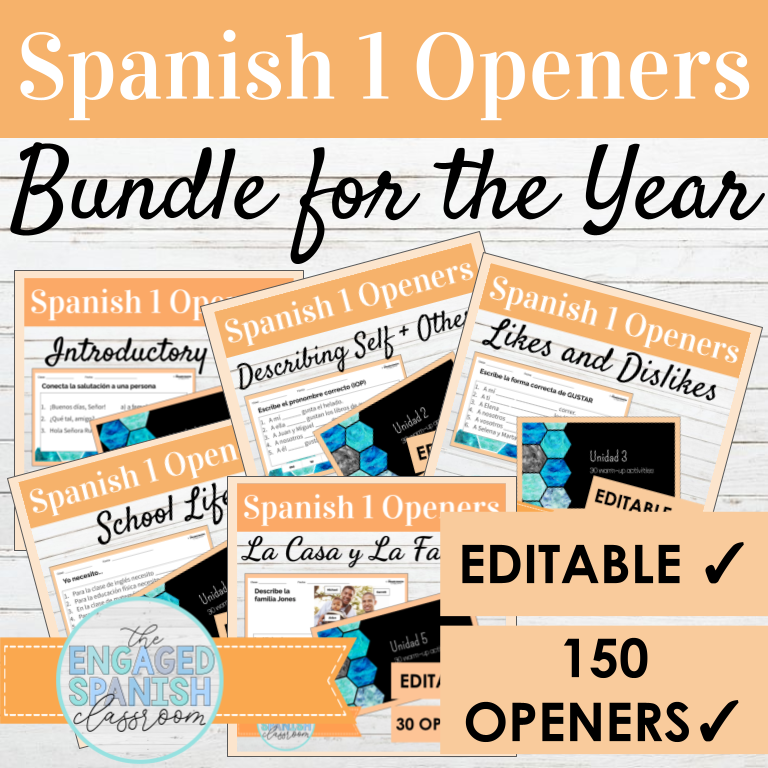
I also have various puzzles and quick activities that I sometimes use for openers (available for all levels) here.
And again, I love keeping myself and my students organized with the warm-up pages of my planners, and digitally with my Editable Class Hub Sites. These are perfect for when I make my own warm-ups on a weekly/unit basis, and the Editable Hubs are great for teachers who may not have the space to display their warm-ups on the board.
Thank you for reading!
I hope the ideas I shared can help you to feel less stressed and more prepared each day, but I’d love to hear from you in the comments! As teachers, we are all as different and unique as our students – I’d love to hear your go-to routines and what works for you 🙂
If you want to read more about the free digital openers offered above, visit this post before you leave!


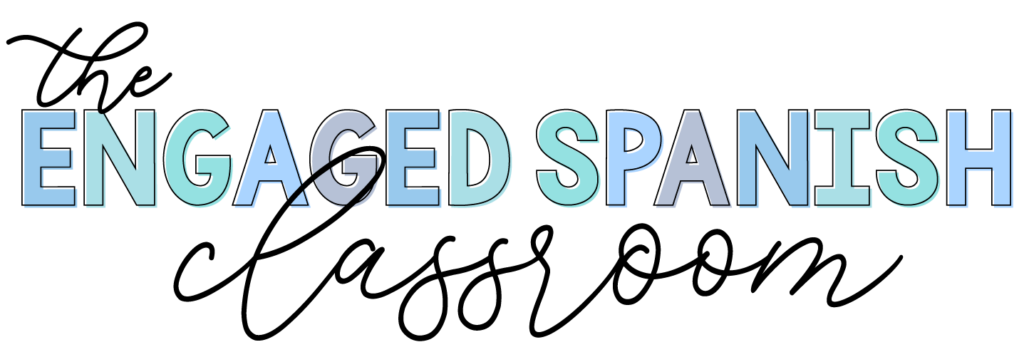
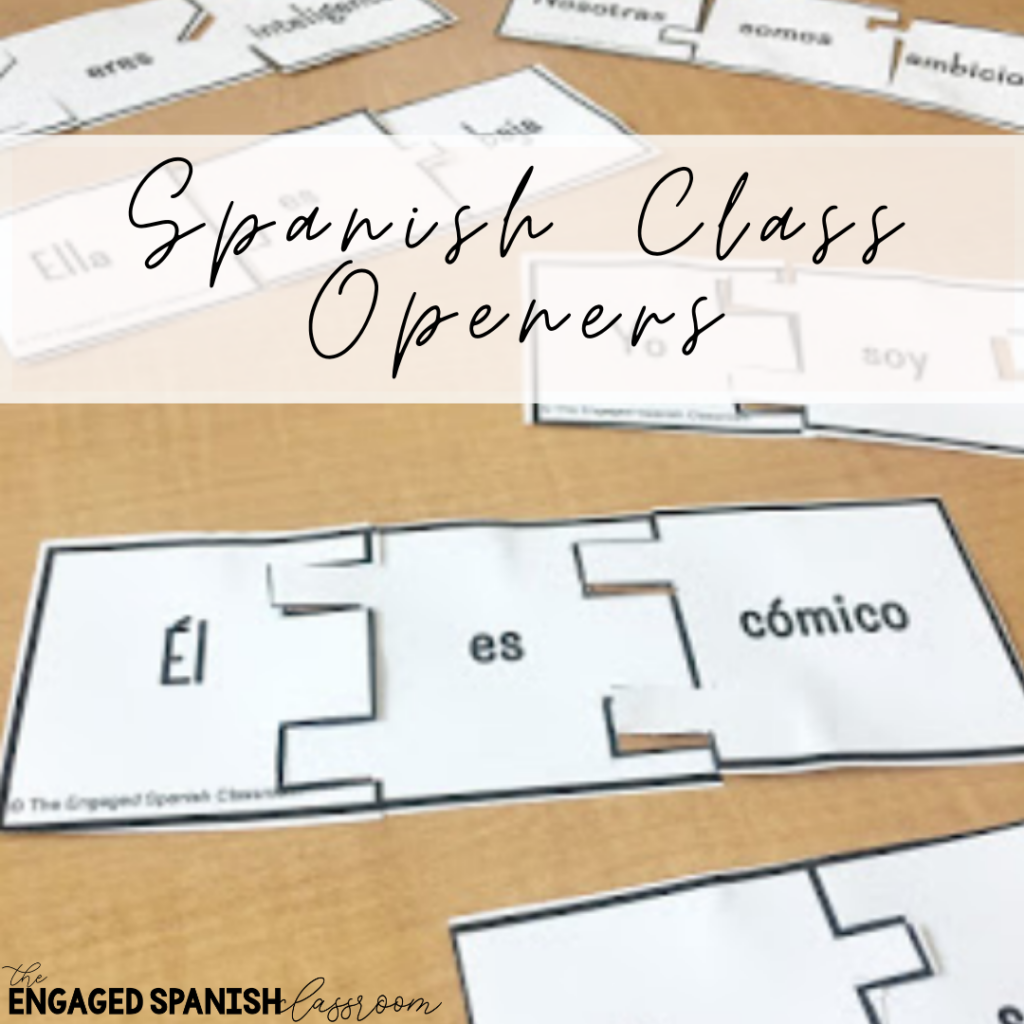
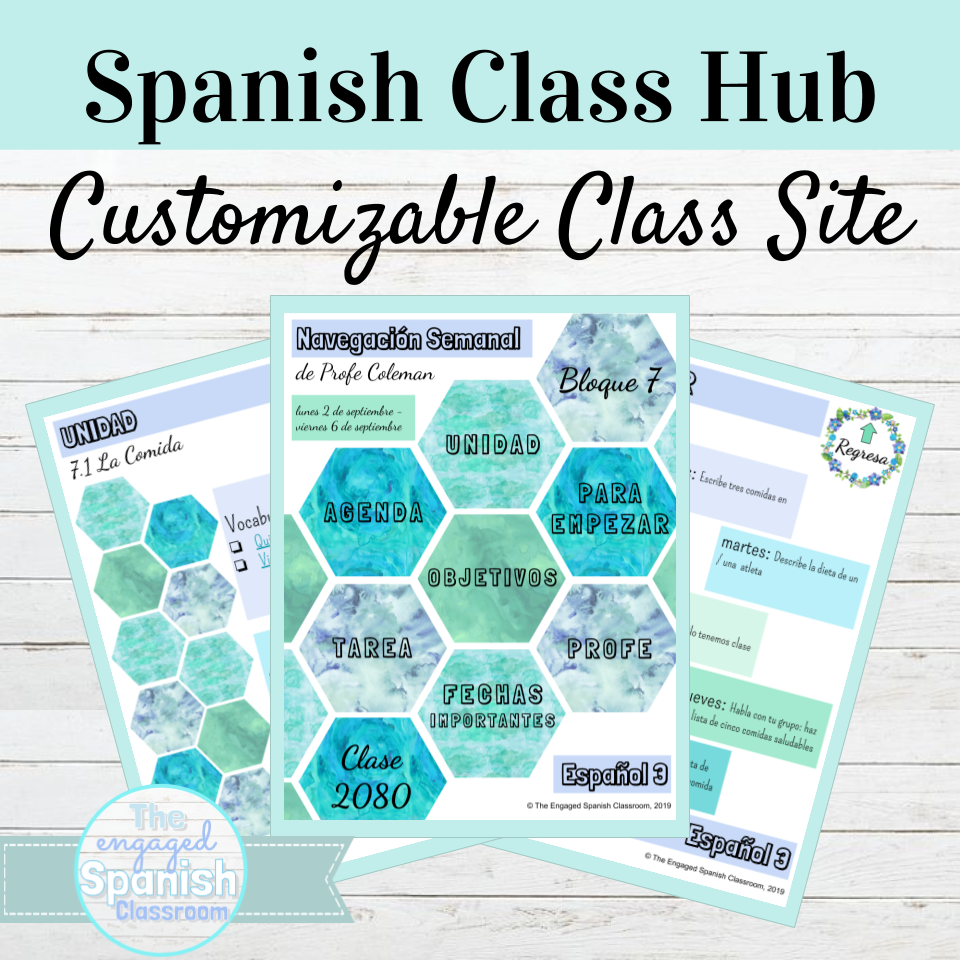
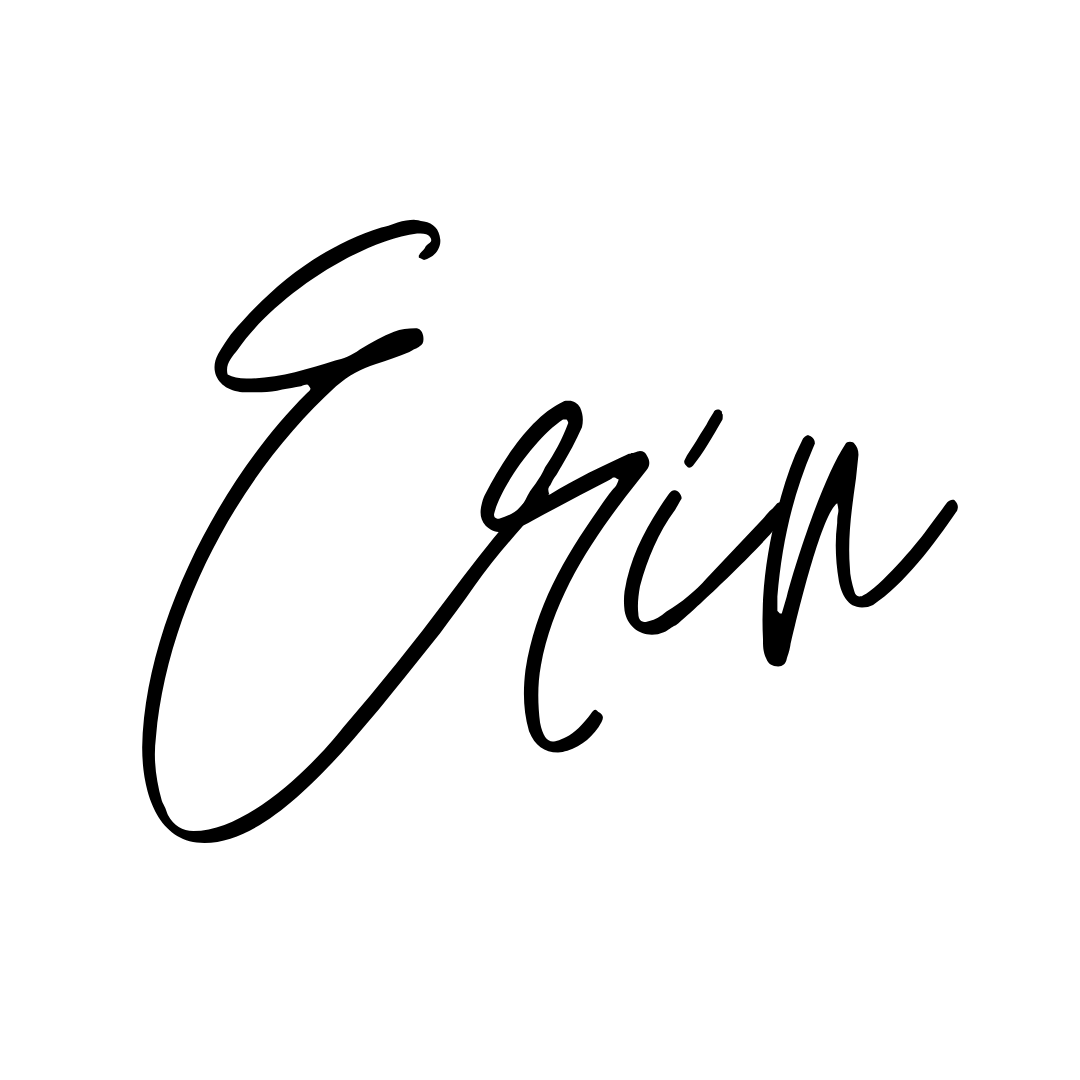

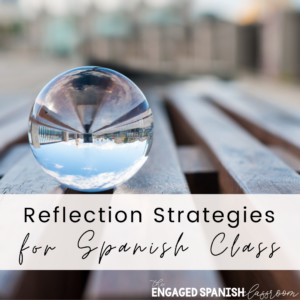
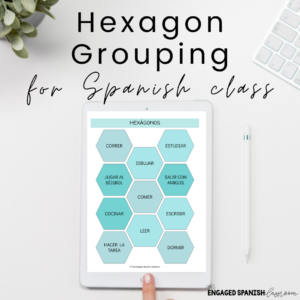


4 Comments
What text book is the standard textbook for your district? I don't mean to imply that you follow one strictly, but my school does. I would be interested to know which one you "follow" or what order for topics and grammar you use, to see whether or not it lines up with ours! 🙂
Hi! Thank you for reading and commenting 🙂 We follow Exprésate technically, however the majority of my department create our own materials and don't use the textbooks other than as a guide for themes/units! I hope this helps!